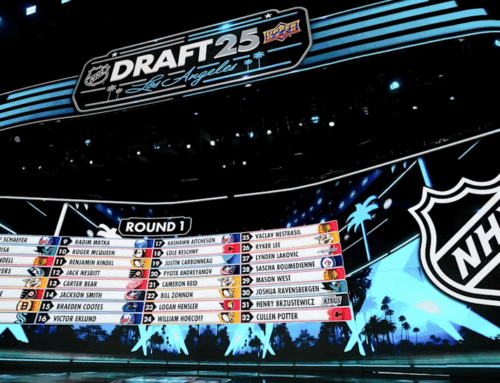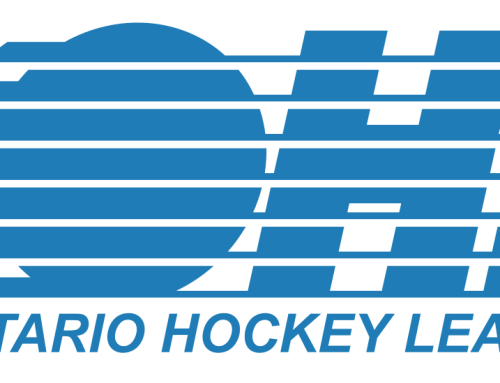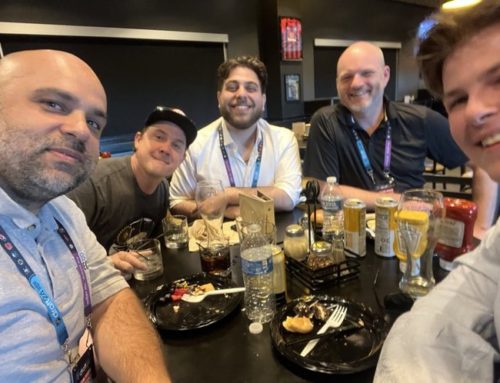Prospect Ramblings: Michigan’s NCAA Dream Team — A Look at the Wolverines’ Current Stars and Future Commits
Hadi Kalakeche
2021-11-09
Welcome to my ramblings, where I’ll be writing down my thoughts on NHL and draft-eligible prospects once a week. I’ll be using the ramblings to keep you posted on the week’s events, and let you in on some questions I ask myself often regarding prospects, amateur scouting and player development.
This week, I wanted to take a look at the Michigan Wolverines, an NCAA program that has catapulted itself into powerhouse conversations seemingly out of nowhere. The program landed four of the top-five picks in the 2021 NHL Draft, a historic achievement that has generated momentum for the team’s recruitment efforts this year. More and more prospects are committing to the Wolverines that are shaping up to be top draft picks in the future, including one of the most promising 2023-eligible junior players in Adam Fantilli.
I wanted to take a quick look at the Wolverines’ current stars and future pieces, while also analyzing what’s to come for the NCAA program; the very nature of college hockey makes retaining top-end talent long-term near impossible. I want to look at how long Michigan can keep this powerhouse title, and if they’ll ever relinquish it after this recent batch of successful additions.
We’ll first count down the 2021 draftees in order, starting with the first-overall pick:
Owen Power, LD — Buffalo Sabres
Power’s 2021-2022 campaign is off to a great start, as the prospect’s production has stepped up since last year. The towering blueliner has been using his size (6-foot-6, 214 pounds) and reach a bit more to his advantage, leading him to jump his production rate from 0.62 last year to 1.20 this year, as Power has two goals and 10 assists through 10 games to start the year. This includes six points in his last four games, all of which came against decent programs in Michigan State and Wisconsin. He leads the team’s defensemen in points, and is tied for second with forwards included. He also remains as disciplined as he was last season, with only three minor penalties drawn so far despite being one of the most regularly-involved defensemen away from the puck.
Jimmy Lambert intercepts and feeds Owen Power for the goal pic.twitter.com/fiodCOB9Pw
— Michigan Hockey (@umichhockey) October 29, 2021
Power can sometimes be a bit too restrained and inactive around his net, and his passing consistency could be better, but he is still managing to show the improvement and adaptability expected from a first-overall selection. If he continues to apply these concepts to the more intricate details of his game, he could very well reach his top-pair ceiling.
Matty Beniers, C — Seattle Kraken
Beniers has more or less maintained his point-per-game pace from his draft year with nine points in 10 games this season, but the assistant captain has seen an uptick in his goal-scoring with a jump from 0.42 goals per game to 0.6. He scored four goals in the Wolverines’ back-to-back against Michigan State over the weekend, all four of which came in the first period. His defensive involvement has been just as good, as the prospect regularly manages to use his tenacity and drive to play pucks up the boards and away in his own zone, while being alert and active in the neutral zone to break up entry attempts. Beniers’ skating is refined as well, and he’s been using his edgework a bit better by applying the correct cuts and shuffles at the right times, and maximizing his linear crossovers when accelerating with the puck. He has an added shiftiness about him on controlled breakouts as a result, but his actual puck skills — stickhandling, passing and shooting — do let him down on occasions.
🚨 BENIERS with the snipe 🔥assisted by Johnson & Power pic.twitter.com/XKpkvONxs5
— Michigan Hockey (@umichhockey) November 5, 2021
A prospect as foundationally sound as Beniers is (almost-ideal skating posture and strides, brilliant offensive and defensive mind, high-end motor and intensity) with only his puck skills to improve is a very interesting project to follow. The Kraken can just find him a skills coach and let them have at it for hours a day, working on utilizing his strengths as building blocks upon which to stack some new-found skills — helping Beniers incorporate his edgework into his shooting by working on foot placement and weight transfer would be a decent start. If Beniers can improve his abilities with the puck, the Kraken could have a future Selke nominee. The rest of his game is ever-improving and regularly on display.
Luke Hughes, LD — New Jersey Devils
Hughes’ season start has been stellar, as the prospect has earned 10 points through his first 10 NCAA games. The 6-foot-2 blueliner boasts tremendous skating and and outstanding offensive mind for the game, and his ability to create and execute flawless passes through the narrowest of seams has been on display so far. The prospect’s September 9th birthday means he was only six days away from being eligible for 2022 instead, which makes him one of the more productive 18-year-olds in NCAA history; in fact, only Adam Fox had a higher NCAA point-per-game pace before turning 19, and that was with Harvard in the ECAC, a division which is much weaker than the Big-10, and was even weaker back in 2016-2017.
#NJDevils top prospect Luke Hughes with a nifty goal for Michigan. 👀
— Kyle Cannillo (@KyleCannillo) November 6, 2021
Hughes’ manipulation when closing down from the point and when carrying the puck through the neutral zone make him a regular chance-creator, and improving his average shooting will go a long way in making him a more complete offensive defenseman. He distributes the puck like few can, but sometimes struggles with beating goaltenders clean. The defensive side of his game could also use some fine-tuning; he uses his stick very well to angle opponents away, which allows him to defend the rush efficiently, but doesn’t layer his stick and body checks to maximize his chances of dislodging the puck. He’ll also join the rush too eagerly on occasions, leaving his team outnumbered the other way. If Hughes cleans up these areas of his game, there’s the offensive upside to have him become a top-five NHL point-producing blueliner.
Kent Johnson, C — Columbus Blue Jackets
Johnson’s draft-year production for the Wolverines reached 27 points in 26 games, and the prospect has now improved on that rate. Through his first 10 games, the 2021 fifth-overall pick has earned four goals and 10 assists, leading his team by a margin of two points. His production rate also places him ninth all-time among draft +1 forwards, ahead of Thomas Vanek, Jonathan Toews and Dylan Larkin among others. He’s mainly stood out on the power-play, where his mesmerizing puck skills in tight quarters have earned him a fair share of highlight-reel plays. Johnson’s two main issues, skating and defending, have slightly improved but remain setbacks that could infuence his career trajectory.
Proof that Kent Johnson is a WIZARD pic.twitter.com/pN1GRny1VO
— Michigan Hockey (@umichhockey) October 30, 2021
The puck skills that he displays, however, are irreproachable; his bag of tricks seems endless, and both his playmaking and shooting are decent weapons he can utilize from anywhere in the offensive zone. That’s his ticket to the NHL, and I trust the Blue Jackets’ ability to find and develop talent. There are very few misses in their record, despite huge risks such as picking Yegor Chinakhov in the first round (I’m still not over that), and most of it is their ability to identify players who have something special, but who are a couple of key learnings away from greatness. I believe that’s Johnson’s case.
Brendan Brisson, C — Vegas Golden Knights
I could think of no better NHL team for the son of one of the most renowned player agents in the hockey world, Pat Brisson. The Golden Knights’ 2020 first-round pick has been outstanding so far for the Wolverines with 12 points in 10 games, and leads the team in goals with seven. His one-timer has continued to be the weapon it was with the Chicago Steel in his draft year, and the prospect has added more versatility to his goal-scoring game in order to net goals from a variety of positions and situations. He is now three goals away from his total of 10 from last season, with 14 less games played. Not to be controversial or anything, but I think he’s going to surpass the 10 goal mark this year.
🚨 BRISSON on a beautiful angle 🤌 pic.twitter.com/3BmflNjcA9
— Michigan Hockey (@umichhockey) November 6, 2021
When he finally makes it to the NHL, we’ll see a lot of goals from Brisson — that’s almost a given. One thing people underestimate about Brisson, however, is how cerebral he is. Rarely have I seen a player draw in and exploit defensemen like he does. His stickhandling isn’t anywhere near Kent Johnson’s level, but the simple ways in which he creates space for his linemates makes me believe that Brisson is headed towards a fruitful NHL career. The only question, for me, is if he’ll be doing that with the Knights, or if he’ll be dealt in a trade for whichever star the Knights decide is playing for them now. Seriously, how do they manage to get every star that hits the trade block?
Erik Portillo, G — Buffalo Sabres
If only to please my good colleague from Göteborg Patrik Bexell, I wanted to throw a word in for the Sabres’ third-rounder from 2019. Portillo was drafted out of Frölunda’s J20 program, in which he had a .931 save percentage through 26 games. He joined Dubuque in the USHL the next season, posting a .915 through 27 games. Then, last year, he earned his first college starts with Michigan, and posted an outlandish .935 save percentage and 1.67 goals against average in his seven games, five of which were starts. This year, through 10 games and an 8-2-0 record, Portillo has a respectable .919 and 2.20, which has been a bit more difficult to earn than last season. Each program in the Big-Ten has stocked its cupboards, and the scoring chances against are numerous this year, despite Michigan doing a good job of stifling low-danger shots. I can’t wait to see where Portillo goes from here; I know he’s got more in the tank. He’s huge (6-foot-6, 224 lbs) and exceptionally athletic, while having good poise and recoveries.
Mathieu De St. Phalle (NCAA FA) comes in on the breakaway, but Erik Portillo (#LetsGoBuffalo) stands tall with a huge save to keep Michigan in this hockey game. pic.twitter.com/xMjs8PD4WW
— J.D. Burke (@JDylanBurke) October 29, 2021
Now, onto Michigan’s future commits — there are a good number of great ones, so I’ll keep these reports short and sweet.
Adam Fantilli, C (2023) — Chicago Steel
Despite Fantilli being way younger than the other names I’ll mention below, he stands out as the top name to express his commitment to Michigan’s program in 2022. This is an elite center in the making; he is not eligible for the NHL draft before 2023, at which point he’ll be fighting for a top-four spot with Matvei Michkov, Connor Bedard and Dalibor Dvorsky, and yet he already shows so much promise. High-end skating, stickhandling, shooting and playmaking hallmark his offensive game, and his production rate with the Chicago Steel this year leads all USHL players his age. He sits 29th all-time for points by a draft -1 prospect in the USHL this season, and has been underperforming his actual on-ice talent. He should pick it up in the next few months and enter the top-10 in that metric.
Late-night thought: Adam Fantilli is going to be oh-so-good. #2023NHLDraft pic.twitter.com/bsWJrwLPcV
— /Cam Robinson/ (@Hockey_Robinson) May 23, 2021
Frank Nazar, RW (2022) — USNTDP
Nazar has tallied an average of a point per game so far in the USHL through five matches, and has displayed his high-end playmaking and stickhandling on a regular basis. I love the way he thinks the game and manipulates defenders on the power-play. If he could fine-tune his balance, edgework and seam-creation, he would be much better at blending everything together at high speeds. His brain is on display both on and off the puck, as he’ll find and exploit space very well while preparing plays before he even receives a pass, but I’d like to see him get more involved in-between the dots and zip passes cross-ice through lanes he creates for himself. Often he’ll just benefit from his opponents’ lapses in coverage to connect with a teammate. That’s the next step for him: learning to utilize his passing game as a threat rather than just using it as a means to get himself in a better shooting position. He’ll be primed to do that next year, on a Michigan team rife with star talent.
Rutger McGroarty, C (2022) — USNTDP
McGroarty’s standout shooting ability is his main ticket to the pro level, as the prospect can shoot off either foot with weight and accuracy, and doesn’t hesitate to take shots from afar. After initially committing to Notre Dame, McGroarty thought it best to join the horde of high-end talent committed to the Wolverines and be a part of the most likely program to succeed repeatedly over the next few years. The prospect’s skating is a serious concern, as his weight transfer, posture and stride extensions all have a lot of quirks and deficiencies that could hinder his ability to find and exploit pockets of space at the NHL level. If that’s fine-tuned and McGroarty manages to add an effective arsenal of passes to his game, watch out.
Seamus Casey, RD (2022) — USNTDP
Casey’s commitment to the Wolverines’ program will make them much more stable on the back-end once Power and Hughes inevitably leave for the NHL. His short stature (5-foot-10, 161 pounds) hides an outstanding defensive game which is near irreproachable. The layered stick and body defending that I mentioned Hughes lacking earlier is very much present in his prospect, and he outright blocks an outstanding number of opposing zone entry attempts with a regularity and ease that is very promising. On top of that, the prospect boasts the skating and edgework we’ve come to expect from shorter defensemen, and the offensive game that often comes with that as well. I’m excited to see how he can build off his four points in five USHL games so far.
With all this to work with, the Wolverines are on a very promising path of repeated greatness within their program, which could very well create a cycle of acquiring top-end prospects, winning championships, then having those championships and alumni attract other high-end talent to the NCAA team. In a very wide market of development programs for NHL prospects, Michigan is standing out like few have in U.S. hockey history.
– Hadi Kalakeche
Follow me on Twitter @HadiK_Scouting for all of your fantasy prospect needs.






